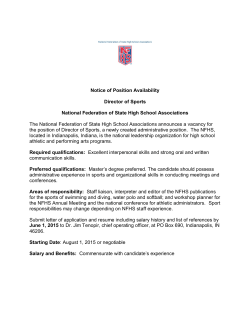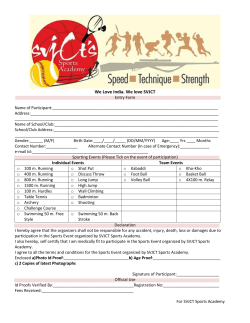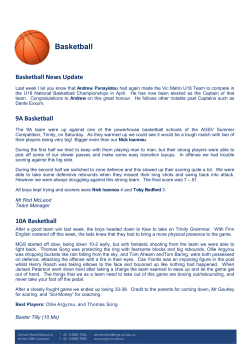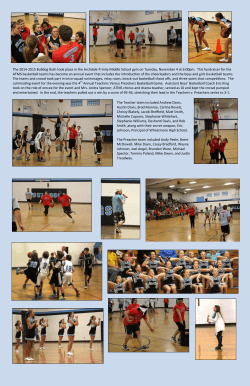
Excessive Contact Rule in High School Basketball Now Includes All
NATIONAL FEDERATION OF STATE HIGH SCHOOL ASSOCIATIONS NEWS RELEASE Excessive Contact Rule in High School Basketball Now Includes All Ball‐Handlers FOR IMMEDIATE RELEASE Contact: Theresia Wynns INDIANAPOLIS, IN (May 18, 2015) — The rule prohibiting excessive contact in high school basketball has been expanded to include all ball‐handlers on the court, include post players. This revision in Rule 10‐6‐12 and a new signal for officials were recommended by the National Federation of State High School Associations (NFHS) Basketball Rules Committee at its April 20‐22 meeting in Indianapolis. Both changes were subsequently approved by the NFHS Board of Directors. Last year, the rules committee added Article 12 to Rule 10‐6 in an effort to eliminate excessive contact on ball‐handlers and dribblers outside of the lane area. Beginning next season, excessive contact on any ball‐handler will be a violation of the rules. The new language states that “a player becomes a ball‐handler when he/she receives the ball. This would include a player in a post position.” The acts that constitute a foul when committed against a ball‐handler are a) placing two hands on the player, b) placing an extended arm bar on the player, c) placing and keeping a hand on the player and d) contacting the player more than once with the same hand or alternating hands. “The current rule covers the ball‐handler/dribbler situations but ignores the action that goes on in the post area with the hands, arm bars, etc.,” said Theresia Wynns, NFHS director of sports and officials. “The additional language will clarify that the illegal acts should be ruled for every position on the floor.” The rules committee also approved a new signal to be used after a basket is made and when there is a stoppage in play. The signal will be used by officials to indicate that the team in‐ bounding the ball may run the baseline. This signal would be used to restart play when a time‐ out is called or an injury occurs after a made basket. In addition to these changes, the Basketball Rules Committee approved four points of emphasis for the 2015‐16 season: post play, rebounding, protecting the free‐throw shooter and NFHS mechanics and signals. The committee noted that new information has been added to the rules book that addresses cleaning up post play and urged fouls to be called when violations occur. In addition, the committee emphasized that illegal tactics related to rebounding should be called since these violations are among the leading causes of injury in high school basketball. Protecting the free‐throw shooter is another area of emphasis for next season. The committee noted that the rule change last year allowing a player occupying a marked lane space to enter the lane on the release of the ball by the free thrower calls for added protection of the free‐throw shooter. The final point of emphasis concerns the use of NFHS mechanics and signals. “Communication is vital to the game of basketball, to the officials and all others involved in the game,” Wynns said. “It is essential for officials to master and use only the NFHS‐approved mechanics and signals.” The rules committee also devoted significant time to updating the NFHS 2015‐17 Basketball Officials Manual. Wynns said the revised publication will be improved and expanded to include diagrams helpful to new officials as well as the more experienced ones. A complete listing of the basketball rules changes is available on the NFHS website at www.nfhs.org. Click on “Activities & Sports” at the top of the home page, and select “Basketball.” According to the 2013‐14 NFHS High School Athletics Participation Survey, basketball is the third‐most popular boys sports nationwide with 541,054 participants and second‐most popular girls sport with 433,344 participants. In terms of school sponsorship, it ranks No. 1 for both boys and girls with 18,126 schools for boys and 17,754 for girls. ### About the National Federation of State High School Associations (NFHS) The NFHS, based in Indianapolis, Indiana, is the national leadership organization for high school sports and performing arts activities. Since 1920, the NFHS has led the development of education‐based interscholastic sports and performing arts activities that help students succeed in their lives. The NFHS sets direction for the future by building awareness and support, improving the participation experience, establishing consistent standards and rules for competition, and helping those who oversee high school sports and activities. The NFHS writes playing rules for 16 sports for boys and girls at the high school level. Through its 50 member state associations and the District of Columbia, the NFHS reaches more than 19,000 high schools and 11 million participants in high school activity programs, including more than 7.7 million in high school sports. As the recognized national authority on interscholastic activity programs, the NFHS conducts national meetings; sanctions interstate events; offers online publications and services for high school coaches and officials; sponsors professional organizations for high school coaches, officials, speech and debate coaches, and music adjudicators; serves as the national source for interscholastic coach training; and serves as a national information resource of interscholastic athletics and activities. For more information, visit the NFHS website at www.nfhs.org. MEDIA CONTACTS: Bruce Howard, 317‐972‐6900 Director of Publications and Communications National Federation of State High School Associations bhoward@nfhs.org Chris Boone, 317‐972‐6900 Assistant Director of Publications and Communications National Federation of State High School Associations cboone@nfhs.org
© Copyright 2025











